|
|
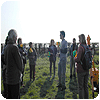










|

|
Hampden Flight
by Sid Deaton |
 |
 |
WAG set out on a field walk on a wet February morning following a fascinating story that unfolded on the
forum about an aircraft crash in a field near Branston. The full
story is told Sid but following the field walk, Jerry speculated about the finds; "Yes it was an interesting morning. On the way home I was
thinking about what we'd found, and was left with the feeling that we weren't finding enough bits to make a fairly substantial twin-engined aircraft. To
investigate this a bit further I printed a drawing off the web and crudely estimated the skin area at 230 sq.m (half this is wings, one third fuselage, and a bit for the
tail). Most of the bits we found were 2 or 3 inches square - we'd get about 200 - 400 per sq.m. This would give a total of 40,000 to 100,000 bits.
Perhaps we found 100 bits and searched 1/10th of the area. Maybe we only probed to about 1/4 of the depth and found 1/3 of the bits in each 10m
square. In other words, our 100 bits are less then 1% of the total." The speculation was shown to be spookily accurate when we
discovered the English Heritage guidance regarding crash
sites that stated; "As a result of contemporary recovery, even where archaeological traces remain, excavation of lowland WWII crash sites
may yield on average only approximately 1% (in weight) of the aircraft. In a very few cases up to 10% may survive, but much of this will be severely distorted and
difficult to identify. Most WWI and inter-war crash sites will yield even less." However Sid tells the full story;
|
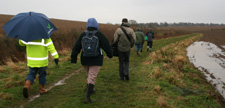
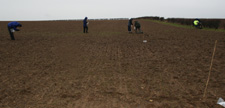
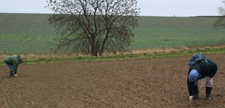
|
Behind my house are two fields I have been lucky enough to gain permission to metal detect on. They were wheat in the
summer and left as stubble until November. I have never been a fan of detecting on stubble, so had stayed well clear until they were disced. On a cold
and breezy day in mid November, I set out on my first outing in the first of the two fields. Several sherds of pottery (Roman and Medieval) and worked flint were
collected from the surface. The only two notable finds below the surface being a Roman AE follis of Constantine depicting 2 soldiers/2 standards dating about
330AD and a medieval casket mount dating approx 1350-1450AD. A week later I was back and decided to try my luck on the other field. Again I found
lots of worked neolithic flint and lots of oyster shell fragments possibly from the Romans or medieval times. As I climbed the hillside towards the centre of
the field my detector screemed out its first find worth digging. This turned out to be the bullet from a .308 shell. Twenty yards on, the same thing happened
again - another bullet. Not making too much of this I continued my path across the field. My next find was a .308 shell but after closer examination I realised
there was still cordite (the propellant) sticking out and the primer was unfired. I have found live rounds before but when my next 5 or 6 finds were also unfired
shells, alarm bells started to ring. The next finds turned out to be pieces of twisted aluminium, black bakalite with electrical components still attached and so on.
Everything pointed towards the wreckage of a crashed aircraft. (Before I continue, its worth noting 2 finds not related to the plane, but found in the middle of
the site. The first was a lead token dating from 1600-1700, and the second and far more impressive piece was the knob from a group V saxon cruciform
brooch). With the afternoon coming to an end, I returned to examine the finds in the comfort of my own home. In the next few days I started
research into crashes over Branston. After cleaning up the shells, I had already narrowed it down to WWII as the date range printed on the bottom of them was
1939 - 1941. The first crash I was made aware of was 2 Lancasters that crashed head on in 1943, but this seemed too late given the dates on the bullets. By pure
fortune I was discussing my finds with a colleague at work and it transpired that his brothers hobby was investigating plane crashes, and believeit or not, he had his
own database of recorded events. A couple of days later an email arrived with all recorded crash sites over/near Branston for WWII. This also included a
fairly detailed map. It was evident that one matched the date on the shell cases and location almost perfectly. A Hampden 1 bomber from 44 squadron had
crashed during September 1941. Having made my Saxon find, I still wanted to work the area but I didn't conciously want to dig up more wreckage. I
had got quite familiar with the signals my detector was giving out for wreckage and shells/bullets and with that in mind I set out one Sunday for another "sortie" on
the field. Again more flint scatter but nothing significant. I skirted the main crash site along the sandy edge of the field and with only ½ hour of daylight left I
started on a path towards home. Atfer a few yards my detector rung out a signal of 35 on the ID scale. This was a bit higher than the shells and a bit lower than
the alloy plane frame. With time short I decided not to dig and carried on for another 5 or 6 yards. Something stopped me and made me go back, I cannot
explain what, probably just curiosity, but I felt the necessity to dig around the signal. The find came out in the first spade full, a piece of shiny metal instantly
recognisable as a watch bezel. |
|
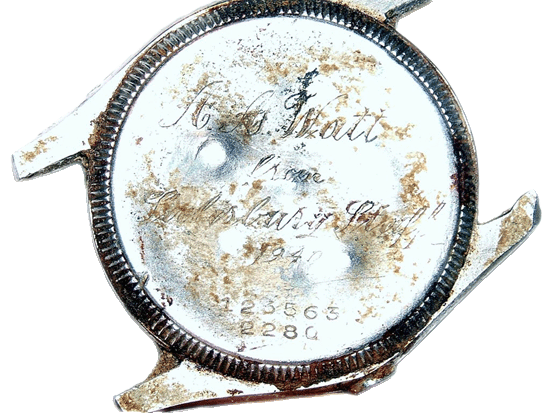
Photo © Sid
Deaton 2007 |
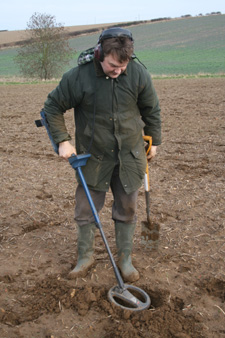 |
What was also quite clear was a beautiful inscription on the back. My heart missed a beat when I made out the first line to be A A Watt,
a name I recognised from the casuality list from the Hampden 1 bomber. This was to be my final dig of the day as curiosity got the better of me and I rushed
home to check the details. The watch was made of stainless steel and was therefore well preserved. The face and hands were missing as was the
strap. Finely and beautifully engraved in the back was the following. A A Watt
from
Salisbury Staff
1941
123563
2280 Indeed he was the pilot of the fated flight. Details as follows: The Hampden 1 bomber was part of 44 squadron, who at that time, were
based in Waddington. The aircraft took off from Waddington at 21.15, on the 7th September 1941, it was caryying a mine that was to be dropped in Kiel Bay,
Germany - a mission known as "gardening". It crashed just 2 minutes later after failing to gain height. The mine and fuel tanks exploded on impact killing all 4
people on board. Details below |
|
| No |
Surname |
Rank |
Service Number |
Date of Death |
Age |
Regiment Service |
Cementry/ Memorial Name |
| 1 |
Watt, Archibald Allen |
Sergeant |
778354 |
07/09/41 |
26 |
RAF Volunteer Reserve |
Waddington (St Michael) Churchyard |
| 2 |
Newcombe, James Risdon |
Sergeant |
928443 |
07/09/41 |
21 |
RAF Volunteer Reserve |
Dagenham (Chadwell Heath) Cemetery |
| 3 |
Wimbush, Adrian Durrant |
Sergeant |
1164655 |
07/09/41 |
25 |
RAF Volunteer Reserve |
Birmingham (Brandwood End) Cemetery |
| 4 |
Cox, eddy Stewart |
Sergeant |
623823 |
07/09/41 |
Unknown |
RAF |
Waddington (St Michael) Churchyard |
|
| A A Watt was the pilot and the oldest known person on board the plane, quite some responsibility for a 26 year old, probably with very
little training. Personal details are; |
| Name: | Watt, archibald Allen |
| Initials: | A A |
| Nationality: | United Kingdom |
| Rank: | Sergeant (Pilot) |
| Regiment/Service: | Royal Air Force Volunteer Reserve |
| Unit Text: | 44 Sqdn. |
| Age: | 26 |
| Date of Death: | 07/09/1941 |
| Service Number: | 778354 |
| Additional Information: | Son of Harold and Maud Watt, of Bulawayo, Southern Rhodesia. |
| Casualty Type: | Commonwealth War Dead |
| Cemetery: | Waddington (St. Michael) Church Yard |
|
You will see his service number does not tie up with the numbers inscribed on the watch. There is a possibility that he may have
transferred from the army to the RAF - this apparently happened frequently. He was in the RAF Volunteer Reserve, so the numbers may have been his original reserve
number and unit. I think this is the most likely explanation as the reserve squadrons had four numbers (2280). Salisbury could have been 2280 Volunteer
Reserve Squadron base and also Watt's home town. What of the watch? If I cannot trace any family (looking unlikely) the watch will go to an aviation
Museum so the history of this flight and the memory of these courageous people, who gave their lives, can live on. To close I would like to say a big thanks to
Mike Warner for all the information he provided me. I am sure I would still be trying to trace the correct details even now were it not for him. Thanks also to all the WAG
members for their interest and information given to me. |
In Memory of
Sergeant ARCHIBALD ALLEN WATT
778354, 44 Sqdn., Royal Air Force Volunteer
Reserve
who died age 26
on 07 September 1941
Son of Harold and Maud Watt, of Bulawayo, Southern Rhodesia.
Remembered with
honour
WADDINGTON (ST. MICHAEL) CHURCHYARD
|
|
| Photos: © Jo Turner 2007 except as noted |
|
| Back |
© Washingborough Archaeology Group, 2003-2007 ©
v.4 'Rise of the
Screen' |
|






















